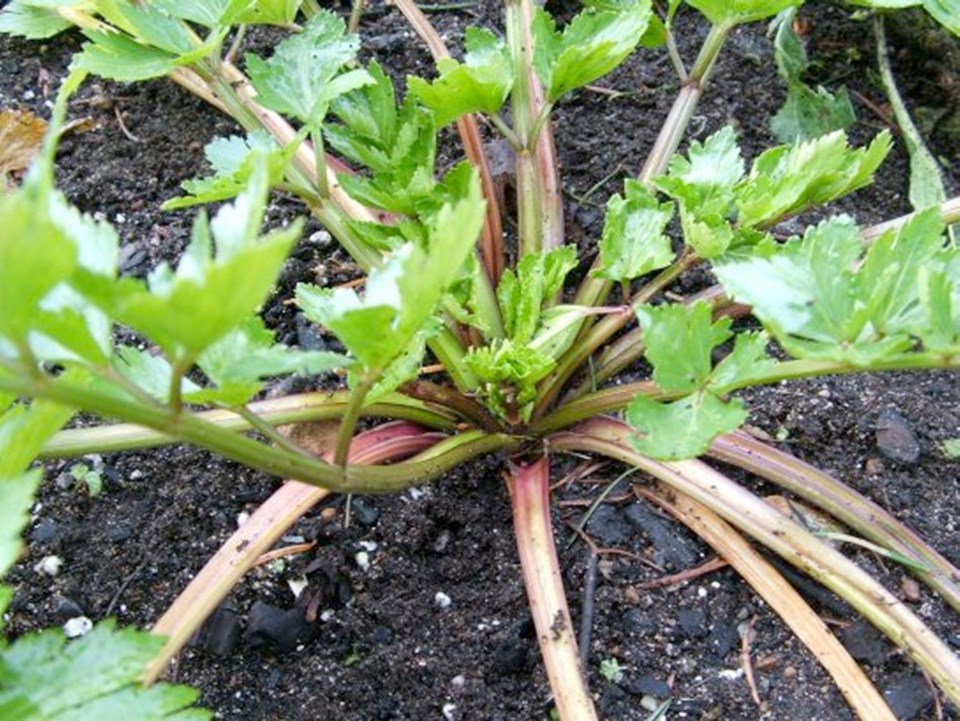Dear Helen: My family has decided to extend our food garden this year to include a few more of our favourite vegetables. One of them is celery, but we’ve heard it can be difficult to grow well. Have you any thoughts on this?
L.C.
Celery is one of the more demanding vegetables. It requires a highly humus-rich, consistently moist and fertile soil. The plants tend to produce naturally at their best in heavy soils with a texture that is retentive of moisture and nutrients.
Over the years I’ve tried different varieties of celery in my very light-texture, fast draining sandy soil, with varying degrees of success. I’ve been impressed with red-stalked varieties. The ones I tired produced some upright stalks and others that are closer to the horizontal.
I found the flavour pleasing and the plants were surprisingly hardy. West Coast Seeds lists a red-stalked celery called Redventure, which the catalogue describes as producing “beautiful, crunchy stalks that are full of celery flavour.”
Golden Self-Blanching is an heirloom variety that has done well in my garden. The stalks are tender and crisp. William Dam lists it.
I haven’t grown it yet, but I notice that Tango is recommended in several catalogues as being the most heat tolerant and generally adaptable to a wide range of growing conditions. Both West Coast Seeds and William Dam list Tango.
Celery transplants will also be available at most garden centres in the spring. Prepare the soil well with compost or/and composted manure and fertilizer. Select a site that will be easy to keep consistently and generously moist.
Dear Helen: I have a few young cutting-grown zonal geraniums growing at my brightest window. They have done well from an early autumn rooting, but some of the lower leaves are beginning to turn yellow. I am watering them regularly. Can you explain the yellowing?
R.G.
It is a normal part of the aging process in more mature plants for the lower leaves, which are the oldest ones, to turn yellow. The remedy for that is to remove them.
It is usual for most house plants to struggle a bit in the heated air and dim natural light of winter, when the object is simply to keep them alive until light levels elevate enough to perk the plants up. Until then, it is best to accommodate their winter “resting” period by reducing their water supplies.
Zonal geraniums are water-thrifty plants that should never be grown in very moist soils. Keep them on the dry side for the rest of the winter. New growth will indicate entry into a more active growth phase. Then, the plants will be able to use a little more water.
Dear Helen: I found one of your columns last month on ground covers for dry shade with tree root competition most interesting. Where can I find some of the plants you mentioned? Vanilla leaf, salad, and low-growing Oregon grape were among them.
G.J.
The first thing I’d do is check with friends who might have some of these native ground covers. My garden was carved out of woodland and still harbours broad patches of the three plants you mention. You may know someone who would be happy to share a few of these plants.
Almost all garden centres have a section of native plants. Consider phoning a few of your local stores to determine a source, and pick up plants early in the spring.
A mail order source for native plants is Fraser’s Thimble Farms (thimblefarms.com). For vanilla leaf look under Perennials for Achlys triphylla. In the Shrubs section you’ll find salal (Gaultheria shallon) and both low Oregon grape (Mahonia nervosa) and creeping mahonia (M. repens).
GARDEN EVENTS
Seedy in Saanich. The district of Saanich and the Horticulture Centre of the Pacific present Saanich Seedy Saturday on Saturday, 10 a.m. to 2 p.m. at HCP, 505 Quayle Rd. The event features 31 vendors selling organic seeds, plants, produce and more. There will be a children’s table and a community seed swap. Dan Jason of Salt Spring Seeds will speak about his latest book, Changing the Climate with the Seeds we Grow. Dan will present his talk at 11 a.m. and 1 p.m. Admission of $8 includes free entry to the gardens. Free admission to children under 12.



